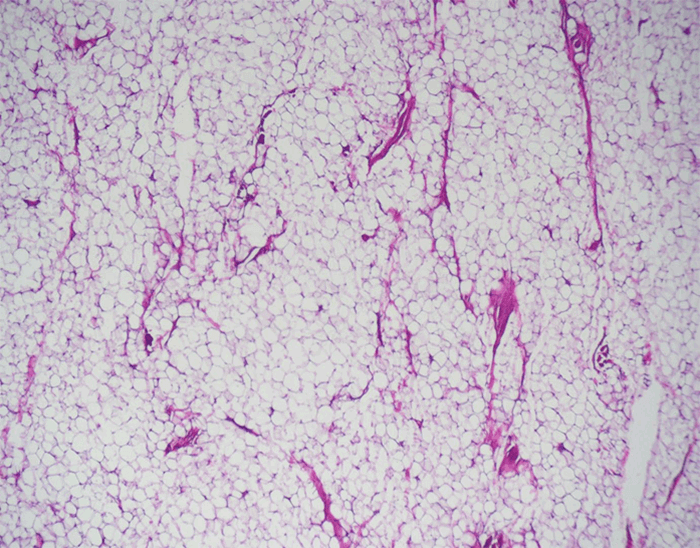Discussion
Lipomas are the most common benign soft-tissue neoplasm in adults.3 They are most often found in the trunk or upper extremity, and they most often present in subcutaneous planes of areas with increased adiposity. They rarely involve the hand, and masses involving the fingers may represent less than one percent of all lipomata.1 Only a handful of digital lipomas are described in the literature, but greater than one-third (35.14 percent) involved the middle finger.2,4 Reports associate these tumors with neuropathic pain, paresthesia, restricted range of motion, bony erosion, and decreased nail bed perfusion.4 Histologically, they do not differ from lipomas in more classical anatomical locations and consist of mature adipocytes covered by a thin fibrous capsule. Gross examination of lipomas, most typically show well-circumscribed masses with a yellow appearance.
Given their rarity, lipomas are often excluded from the differential diagnosis of slow-growing, painless masses of the finger, which are more commonly attributed to mucoid cysts, inclusion cysts, or giant cell tumors.5 In fact, recent metanalyses of these lesions revealed that most were not diagnosed or considered until after excision.4 One case reported involvement of the digital nerve6 but failed to describe its relationship to the artery. Several others have associated the neoplasms with middle finger paresthesia and pain,4 which may be attributable to involvement or entrapment of the neurovascular bundle.
This current case is notable in respect to the size of the lipoma and separation of the digital artery and nerve, a phenomenon not previously described in the literature (to the best of the authors’ knowledge). With regard to size, only two previously described cases involving the middle finger were larger than the mass found in our case.7,8 This previously unreported involvement of the neurovascular structures should be considered during the excision of large lipomas and may be a source for commonly reported paresthesia in digital lipomas.
Conclusion
Lipomas should be included in the differential of large digital tumors, especially when associated imaging appears homogenous. Digital lipomas, while rare, have the potential to separate the neurovascular architecture of the finger. This involvement may explain previously described reports of distal paresthesia occurring with these tumors and should be considered during excision.
Lessons Learned
Digital lipomas have the potential to separate the neurovascular architecture of the finger and may be associated with distal paresthesia reported with these rare tumors.
Authors
McCulloch ILa; McClellan WTb
Corresponding Author
Ian L. McCulloch, MD, MRes
16 Willow Lane
Morgantown, WV 26505
Phone: (304) 237-0173
E-mail: imccullo@mix.wvu.edu


